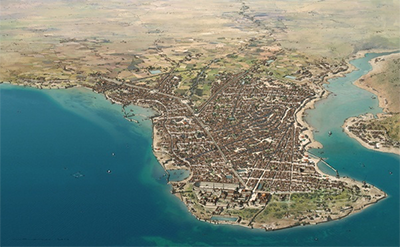The Byzantine Empire
Part 2: Constantine's New Capital
When that famous emperor died, in 337, he passed his throne on to his three sons, Constantine II, Constans, and Constantius II. Of those, the latter was emperor in the East and served in that capacity until 361, meeting death at the hands of the usurper Julian. Julian, head of both halves of the Empire, lasted just two years on the throne, dying on campaign in Persia; his captain of the guard, Jovian, took his place but then died on campaign as well. The military installed another of their own, Valentinian I, as The eldest son of Theodosius, Arcadius, was then emperor in the East. (His brother Honorious ruled in the West.) Succeeding Arcadius, who ruled for 13 years, were his son, Theodoius II, and his daughter, Pulcheria, who reigned along for a few months and then together with her husband, Marcian. Succeeding him in 457 was Leo I, who spent 17 years on the throne and then handed off to his son and grandson, Zeno and Leo II, respectively. Leo II died in 474, and thus it was Zeno who was emperor in the East when the Germanic king Odoacer deposed the last emperor in the West, in 476. The traditions of construction carried on the East, as Byzantine builders produced aqueducts, baths, amphitheaters, and giant racetracks. The most famous building in all of the Eastern Empire was the Hagia Sophia, a massive domed temple in Constantinople. Other such domed temples and churches dotted the various imperial landscapes. |
|
Social Studies for Kids
copyright 2002–2025
David White



 Finally alone at the top, Constantine chose as his new capital Byzantium, an older Greek city. He renamed it Constantinopolis (in English "Constantinople"), and this became one of the world's great cities. He ordered a grand building and rebuilding program, repairing damaged walls and buildings and installing cisterns and other relative comforts. In his new headquarters he ordered built a large Christian church, the Church of the Holy Apostles, along with temples to the gods of other religions and many statues of famous generals like
Finally alone at the top, Constantine chose as his new capital Byzantium, an older Greek city. He renamed it Constantinopolis (in English "Constantinople"), and this became one of the world's great cities. He ordered a grand building and rebuilding program, repairing damaged walls and buildings and installing cisterns and other relative comforts. In his new headquarters he ordered built a large Christian church, the Church of the Holy Apostles, along with temples to the gods of other religions and many statues of famous generals like  emperor; he, in turn, split the Empire again, taking the West for himself and naming his younger brother, Valens, as emperor in the East. It was this Valens who was head of the Roman army at the spectacular defeat at the hands of the Germanic tribes at Adrianople in 378. Valens died in that battle, and his younger brother, Gratian, ruled for a time. Gratian appointed his brother-in-law,
emperor; he, in turn, split the Empire again, taking the West for himself and naming his younger brother, Valens, as emperor in the East. It was this Valens who was head of the Roman army at the spectacular defeat at the hands of the Germanic tribes at Adrianople in 378. Valens died in that battle, and his younger brother, Gratian, ruled for a time. Gratian appointed his brother-in-law, 
